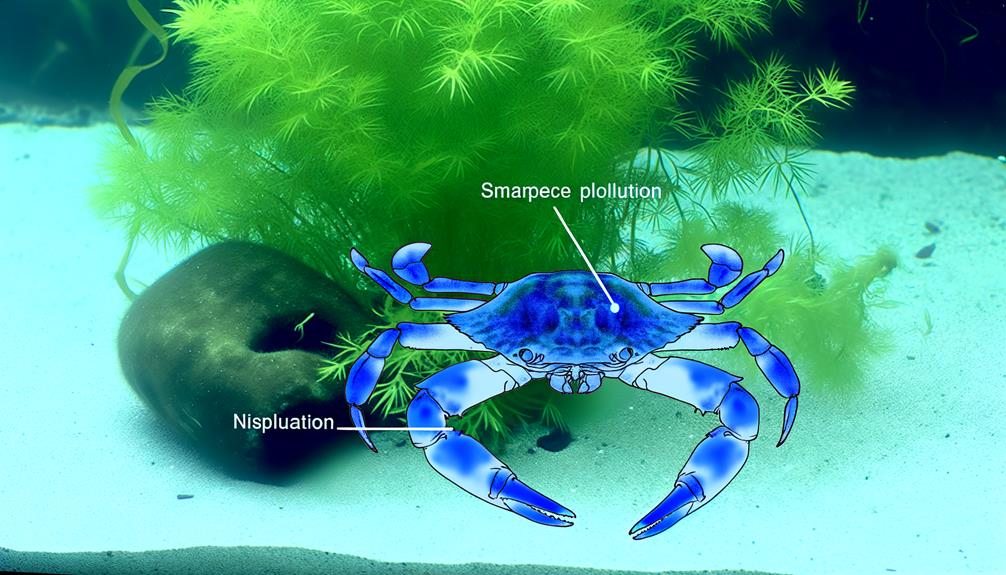Eating Blue Crabs: Weighing Nutritional Benefits and Risks
Blue crabs provide a nutritious option, rich in essential vitamins like B12, C, and A, as well as minerals such as zinc, selenium, and magnesium. They’re high in omega-3 fatty acids, beneficial for cardiovascular health and cognitive function.
With around 18g of high-quality protein per 100g serving, they support muscle growth and recovery. However, be mindful of potential contaminants like heavy metals and PCBs.
Consuming 2-3 servings per week balances nutrient intake and minimizes risks. Cooking methods like steaming retain most nutrients.
By looking further, you’ll uncover extensive health benefits and best practices for enjoying blue crabs.

Key Takeaways
- Blue crabs are rich in essential nutrients like B12, zinc, selenium, and omega-3 fatty acids.
- They provide high-quality protein, offering around 18g per 100g serving, supporting muscle growth and repair.
- Omega-3 fatty acids in blue crabs reduce heart disease risk and improve memory.
- Regular consumption should be limited to 2-3 servings per week to minimize contaminant exposure.
- Steaming blue crabs is a cooking method that retains the most nutrients.
9 Aspects: Are Blue Crabs Healthy to Eat
| Aspect | Details |
|---|---|
| Nutritional Value | High in protein, low in fat, and contains essential vitamins and minerals. |
| Calories | Approximately 85-100 calories per 3-ounce serving. |
| Key Nutrients | Rich in omega-3 fatty acids, vitamin B12, selenium, and zinc. |
| Health Benefits | Supports heart health, boosts immune function, and aids brain function. |
| Cholesterol Content | Contains around 80 mg of cholesterol per serving (moderate consumption recommended). |
| Potential Risks | Mercury content (low, but can accumulate); avoid overconsumption. |
| Allergy Concerns | May cause allergic reactions in individuals with shellfish allergies. |
| Sustainability | Overfishing concerns in some areas, but sustainable fishing options exist. |
| Best Preparation Methods | Steaming, boiling, or grilling with minimal added fats for a healthier option. |
Nutritional Profile

How does the nutritional profile of blue crabs stack up against other seafood options?
You’ll find that blue crabs offer a unique blend of essential nutrients. They’re rich in vitamins such as B12 and minerals like zinc and selenium, essential for immune function and cellular repair. Blue crabs also contain omega-3 fatty acids, which are beneficial for cardiovascular health.
Compared to other seafood, blue crabs have a lower calorie count, making them an excellent choice for weight management. Additionally, their low mercury levels mean you can enjoy them more frequently without the health risks associated with higher-mercury seafood.
Protein Content
In addition to their impressive nutritional profile, blue crabs are an excellent source of high-quality protein, which is pivotal for muscle growth and repair. A 100g serving of blue crab meat provides approximately 18g of protein. This significant protein content supports anabolic processes, essential for maintaining and building muscle tissue.
The high biological value of crab protein means it’s efficiently utilized by your body. Furthermore, blue crab protein contains all essential amino acids, making it a complete protein source. This is particularly beneficial for those who engage in intense physical activities or require enhanced recovery.
Given these attributes, incorporating blue crabs into your diet can support your protein needs without compromising on health or freedom in dietary choices.
Omega-3 Fatty Acids

Blue crabs offer a rich source of omega-3 fatty acids, essential for cardiovascular health and cognitive function. These polyunsaturated fats, particularly eicosapentaenoic acid (EPA) and docosahexaenoic acid (DHA), reduce inflammatory responses and lower triglyceride levels.
Studies indicate omega-3s can mitigate the risk of heart disease, stroke, and even depressive disorders. You’re likely to appreciate the freedom from health concerns that comes with consuming these beneficial lipids.
Moreover, omega-3 fatty acids enhance synaptic plasticity, facilitating improved memory and learning. Regularly including blue crabs in your diet guarantees you gain these critical nutrients, optimizing both your mental and physical well-being.
Vitamins and Minerals
You’ll find that blue crabs are rich in essential vitamins and minerals like vitamin B12, zinc, and selenium.
These nutrients play vital roles in metabolic processes, immune function, and antioxidant defense.
Essential Nutrients Overview
Rich in necessary nutrients, blue crabs provide a substantial amount of vitamins and minerals necessary for maintaining peak health. They’re a remarkable source of vitamin B12, which supports cognitive function and red blood cell formation.
You’ll also benefit from vitamin C, important for immune health, and vitamin A, needed for vision and skin health. Blue crabs are loaded with essential minerals like zinc, important for immune response, and selenium, which has antioxidant properties.
Magnesium and phosphorus are present too, promoting bone health and energy production. Additionally, the high levels of omega-3 fatty acids in blue crabs support cardiovascular health.
Health Benefits Breakdown
Understanding the specific health benefits of the vitamins and minerals found in blue crabs can help you appreciate their role in promoting overall well-being.
Blue crabs are rich in zinc, which supports immune function and wound healing.
The high levels of vitamin B12 in blue crabs aid in maintaining nerve health and producing DNA.
Additionally, blue crabs contain selenium, an antioxidant that protects cells from oxidative damage.
Their significant phosphorus content contributes to bone health and energy production.
Blue crabs also offer a good source of omega-3 fatty acids, which are essential for cardiovascular health.
Potential Contaminants

When consuming blue crabs, it’s important to be aware of potential contaminants. These can include heavy metals, polychlorinated biphenyls (PCBs), and pesticides that can accumulate in their tissues. Studies have shown that these contaminants can pose health risks if ingested in significant amounts. Heavy metals like mercury and lead can affect neurological and renal functions. PCBs, though banned, persist in marine environments and are linked to cancer and immune system disruptions. Pesticides, often runoff from agricultural areas, can bioaccumulate and lead to various toxic effects.
Regular monitoring and adhering to consumption advisories can help mitigate these risks. Ensuring sustainable and clean harvesting practices also contributes to reducing the contaminant load in blue crabs.
Health Benefits
Blue crabs offer numerous health benefits, including being a high-quality source of lean protein, essential vitamins, and minerals like vitamin B12, zinc, and omega-3 fatty acids.
Consuming blue crabs can enhance your metabolic processes due to their rich vitamin B12 content, which is vital for energy production and neurological function. Their substantial zinc levels support immune system efficacy and cellular repair.
Omega-3 fatty acids in blue crabs are known for promoting cardiovascular health, reducing inflammation, and improving cognitive function. These nutrients collectively contribute to maintaining your overall well-being.
Additionally, the lean protein found in blue crabs aids in muscle growth and repair, making them an excellent dietary choice for those seeking a balanced and nutrient-dense food option.
Dietary Considerations

When weighing blue crabs as a dietary choice, you should examine their nutritional value, including protein, vitamins, and minerals.
Be aware of potential allergens and sensitivities associated with shellfish.
It’s also important to take into account recommended consumption frequency to avoid any adverse health effects from contaminants like mercury.
Nutritional Value Breakdown
You’ll find that blue crabs offer a rich source of lean protein, essential fatty acids, vitamins, and minerals, making them a nutritious addition to a balanced diet. Lean protein supports muscle growth and repair while keeping calorie intake low.
Blue crabs are also rich in omega-3 fatty acids, which promote cardiovascular health. They contain significant levels of vitamins B12 and C, enhancing neural function and immune response.
Key minerals like zinc, copper, and selenium are present, contributing to enzymatic functions and antioxidant defense. Additionally, the low mercury content in blue crabs makes them a safer seafood option.
Including blue crabs in your diet can help achieve a thorough nutritional profile while supporting overall health and well-being.
Allergies and Sensitivities
While blue crabs offer significant nutritional benefits, it’s important to take into account potential allergies and sensitivities that may arise from their consumption. Shellfish allergies are relatively common and can trigger adverse reactions, including anaphylaxis, which requires immediate medical attention. You should be aware that symptoms such as hives, swelling, digestive distress, and respiratory issues can manifest rapidly.
Additionally, individuals with known sensitivities to crustaceans should exercise caution. Cross-reactivity with other shellfish is also possible, complicating dietary choices. Scientific studies indicate that the protein tropomyosin is a primary allergen in blue crabs, provoking immune responses.
Always consult healthcare providers for personalized advice, especially if you have a history of food allergies or sensitivities.
Recommended Consumption Frequency
To optimize health benefits and minimize risks, it’s advisable to consume blue crabs in moderation, typically no more than two to three servings per week. This recommendation is based on the need to balance the intake of essential nutrients like omega-3 fatty acids, protein, and vitamins with the potential exposure to contaminants such as mercury and polychlorinated biphenyls (PCBs).
Evidence suggests that excessive consumption of seafood can lead to bioaccumulation of these harmful substances, posing long-term health risks. Adhering to this frequency allows you to enjoy blue crabs’ nutritional benefits while mitigating adverse effects.
Moderation guarantees a diversified diet, granting you the freedom to savor a variety of seafood without compromising your health.
Cooking Methods
Steaming blue crabs is a popular method that preserves their natural flavors and retains more nutrients compared to boiling. By steaming, you minimize nutrient loss, ensuring higher retention of essential vitamins and minerals. Additionally, steaming leads to a firmer texture and more concentrated taste.
Here’s a comparison of cooking methods:
| Cooking Method | Nutrient Retention |
|---|---|
| Steaming | High |
| Boiling | Moderate |
| Baking | Moderate |
| Frying | Low |
Steaming is also quicker and requires less cleanup, making it an efficient choice. If you’re aiming for a healthier option, avoid frying, which adds unnecessary fats and calories. Baking offers a good alternative, providing balance between flavor and health benefits. Choose the method that aligns with your health goals and culinary preferences.
Conclusion
Eating blue crabs is like striking nutritional gold. You’re not just getting a protein powerhouse; you’re indulging in a feast of omega-3 fatty acids, essential vitamins, and crucial minerals.
Sure, there’s a risk of contaminants, but the health benefits far outweigh the cons. With proper cooking methods, blue crabs transform into a superfood marvel.
Embrace this dietary treasure and elevate your nutrition game to unprecedented heights. Engage and savor the unparalleled health advantages.






